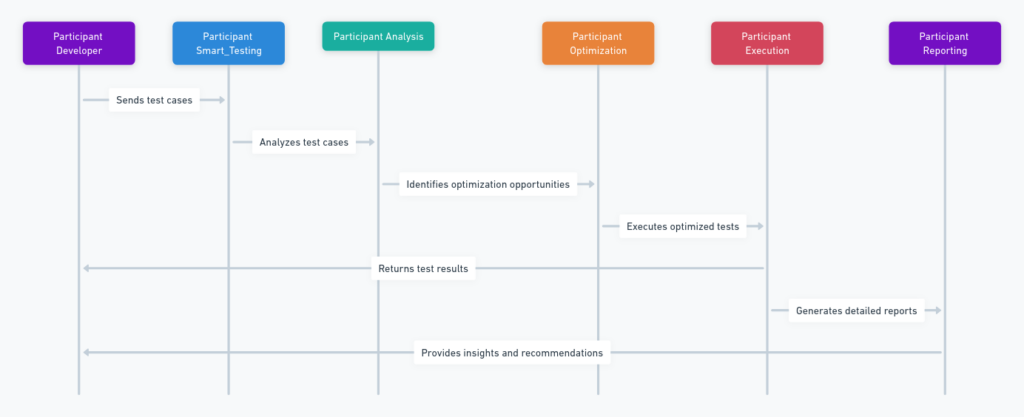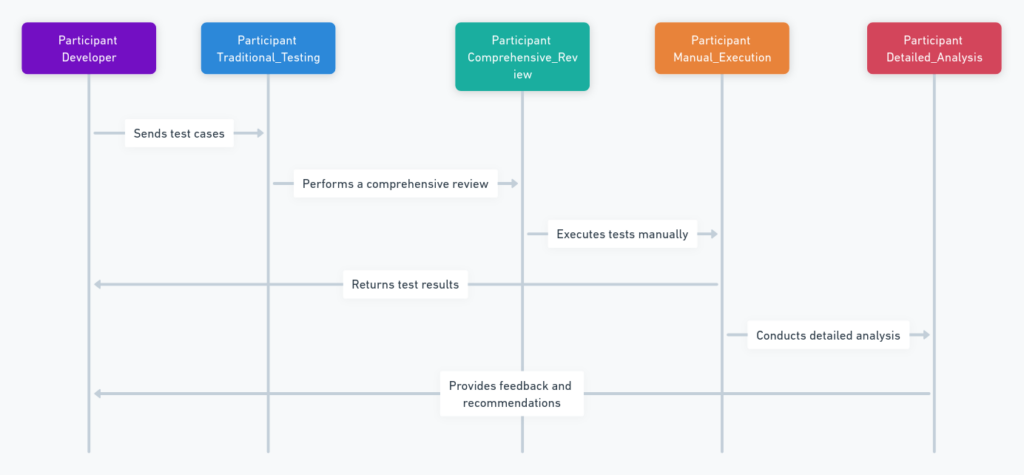The traditional testing methods have been the basis for understanding the complexities that go into ensuring the quality of software. Read the comparison of Smart Testing vs Traditional Testing.
With the development of cutting-edge technologies and agile approaches Smart testing has become a leader with a promise of improved effectiveness and individualized testing strategies.
The concept is "smart testing" is steadily becoming a key element in the testing automation and quality assurance field, changing the way testers conduct their testing by using analytics machine learning, machine learning, and advanced algorithms to predict and spot potential problems early.
Knowing the distinctions between traditional testing and smart testing is not merely the matter of semantics but also of being aware of the evolution of the software testing paradigm.
Each approach has distinct benefits, challenges and best practices. In our exploration of these distinctions, we hope to provide information that will help testers, software developers, and managers of projects to come up with educated decisions in integrating and switching between these approaches to increase the overall quality and effectiveness of their development cycles for software.
Understanding Smart Testing vs Traditional Testing
Definition of Smart Testing
Smart Testing is a new method of testing software that makes use of Artificial Intelligence (AI) as well as machine-learning (ML) techniques to improve the process of testing.
Contrary to traditional testing techniques smart testing focuses on enhancing tests by prioritizing test efforts in accordance with risks and impacts, and automatizing repetitive tasks.
This approach is designed to adjust to the changing environment of software swiftly which makes it extremely efficient in continuous integration as well as delivery pipelines.
Definition of Traditional Testing
Traditional testing, on other hand, is an elaborative process of testing software for defects or bugs prior to its being made available for sale.
The process follows a defined sequence of steps that includes the design, planning, execution and evaluating tests, with no dependence on automation or AI technology.
Traditional testing is demanding and time-consuming as it requires a thorough understanding of every aspect of the software in order to guarantee the highest quality.
Benefits of Smart Testing

Efficiency in Test Automation
One of the main advantages that smart testing has is the efficiency in automating tests.
Through the use of AI as well as ML algorithms Smart testing tools are able to determine the most relevant test scenarios by analyzing them automatically, reducing redundancy which speeds up test process.
This not only reduces time but also provides a greater quality of accuracy in identifying issues that could be.
Focus on High-Risk Areas
Intelligent testing strategies focus testing efforts to high-risk parts of software. Based on previous test results as well as user behaviour and changes to code, intelligent testing tools can identify what components of the application will most likely have flaws.
This method of analysis assists in the early detection of crucial issues, which reduces the possibility of software malfunctions and enhancing general quality and performance of the application.
Challenges of Smart Testing
Skillset Requirement
Implementing smart testing strategies, like tests that are automated or with AI strategies requires specific knowledge that aren't easily accessible in all companies.
A familiarity with the practices of software development as well as knowledge of automation tools, as well as understanding the concepts of machine learning are crucial to ensure that smart testing is effective.
This may require the hiring of experts or investing in education for employees already in the company and both can be a major challenge.
In addition, changing to a more efficient testing method could delay testing procedures when teams are on their learning curve.
Initial Investment
The transition to intelligent testing requires significant initial investments in terms of both personnel and technology. purchasing or licensing advanced testing software, establishing the infrastructure required and distributing resources to maintain and updates could result in significant expenses.
This financial commitment could be particularly difficult for smaller businesses or projects with limited budgets. In addition, the cost-benefit calculation of using smart testing tools can not always be easy, which makes it challenging for some businesses to justify the initial expenditure.
Benefits of Traditional Testing

Thoroughness in Manual Testing
One of the major advantages of manual testing is the depth of it. Testers who are human bring a degree of insight and understanding to the test that is impossible to replicate using automated systems.
They can spot small usability problems, comprehend the intricate user interactions, and provide precise feedback regarding how users interact.
This kind of in-depth testing is particularly valuable at the beginning of development as well as for applications where the interface and overall user experience are important.
Established Processes
The traditional testing techniques are based on established methods and procedures that have changed over the years. Companies have developed thorough tests protocols, standards for documentation and quality assurance methods that are well-known to professionals in the field of testing.
This wealth of information helps to ensure consistency in quality, reliability, and consistency when it comes to testing.
These proven processes also offer a systematic test procedure and make it simpler to educate new testers as well as ensure high quality assurance throughout different projects.
Challenges of Traditional Testing
Time-Consuming
The traditional testing techniques are slow because they are manual. Testers have to complete tests one at a time and this can drastically reduce the time needed to develop.
Manual testing also increases the possibility for human mistakes, thereby making the testing process more difficult. The amount of time needed for thorough testing can cause delays in product release which can impact market competition and operational efficiency.
Limited Scalability
Another issue that traditional testing faces is its inability to scale. As software projects increase in size and complexity manual testing is unable to keep pace.
It is becoming increasingly difficult to cover all scenarios of testing fully without exponentially increasing testing time frame and the demand for additional resources.
This issue of scalability does not just impacts an assurance of quality process, but can also impact costs and allocation of resources for projects.
Comparison of Smart Testing and Traditional Testing
| Criteria | Smart Testing | Traditional Testing |
|---|---|---|
| Speed of Execution | High - Automated tools enable rapid execution of thousands of test cases, significantly reducing test time. | Low - Manual processes are slower and more prone to errors, extending the duration of the testing phase. |
| Test Coverage | High - Capable of running and repeating tests in varied scenarios swiftly, ensuring extensive test coverage. | Limited - Speed and scalability constraints hinder the ability to cover as many test scenarios. |
| Adaptability to Changes | High - AI-based automation tools quickly adjust tests and strategies to accommodate code changes. | Low - Manual efforts to adapt tests to changes are time-consuming and less efficient. |
Criteria: Speed of Execution
When comparing smart testing to traditional testing one of the biggest distinctions is the speed of execution.
The smart testing method, that usually uses automated tools and methods are able to quickly complete thousands of test cases, dramatically decreasing the amount of time required to test phases.
However, traditional testing relies on manual processes which can be slow and more vulnerable to mistakes.
Criteria: Test Coverage
Test coverage is another crucial area in which smart testing is superior to conventional methods. With the capability to swiftly run and repeat test scenarios in a variety of situations, smart testing guarantees greater coverage of tests.
It is difficult to achieve using traditional testing due to the limitations in speed and scale.
Criteria: Adaptability to Changes
The field of software development can be described as a constantly evolving area, with constant changes and modifications to the code.
Smart testing is able to adapt to these changes due to AI-based automation tools that quickly alter tests and strategies according to the latest needs.
Testing in the traditional way has a problem with flexibility, since changes typically require significant manual work which can delay the process of testing.
Implementing a Hybrid Testing Approach
The increasing complexity of software development calls for an approach that incorporates the most effective of traditional and smart methods for testing.
The implementation of a hybrid approach to testing involves using both manual and automated testing techniques to improve quality assurance while also optimizing the time and resources.
Start by identifying the elements of your application could be the most benefit by automated smart testing. Jobs that are time-consuming, repetitive and susceptible to error by humans are the best for testing.
Choose the phases of your development cycle in which traditional testing can provide the greatest value. These typically include areas that require human understanding and intuition like exploratory and usability testing.
Create an adaptable testing plan that permits seamless integration of both approaches. It should contain explicit guidelines regarding how to utilize the automated tools for testing and also when you should trust the skills that manual testers have.
It is important to invest in tools and training that can support both smart and traditional testing techniques. Having your team well-equipped and educated about both approaches will result in a more efficient and efficient testing process.
The implementation of a hybrid approach allows for the development of a more comprehensive test method.
Teams can benefit from the speed and effectiveness of automated testing while still maintaining the valuable information that manual testing offers.
This balance results in better quality software, higher customer satisfaction, as well as a more flexible adapting to the ever-changing demands for software creation.
Book a Demo and experience ContextQA testing tool in action with a complimentary, no-obligation session tailored to your business needs.
Conclusion
In the end, the shift of testing software from traditional techniques to intelligent testing methodologies is a major improvement in the quest for efficiency, accuracy, as well as security in the technology sector.
Although traditional tests have laid the fundamental foundations for testing, intelligent testing utilizes cutting-edge technologies, AI, and automation to improve and speed up the process of testing.
Traditional testing is based on manual effort and is often time-consuming, and vulnerable to human error. However, it is essential to gain a thorough into the system that is being tested.
Smart testing On the other hand is focused on efficiency, using automated instruments and AI to rapidly identify issues as well as predict the outcome and recommend improvements without intervention from humans.
The adoption of a smarter testing method is not a complete solution to the requirement for traditional methods but it does enhance and speeds up the process of testing.
By using the strengths of traditional and smart testing, organizations can have an improved quality assurance processes, ensuring that software is delivered more quickly, at a higher standard and with a budget that is within.
Also Read - How AI is Transforming Smart Testing in the Digital Age
We make it easy to get started with the ContextQA tool: Start Free Trial.
